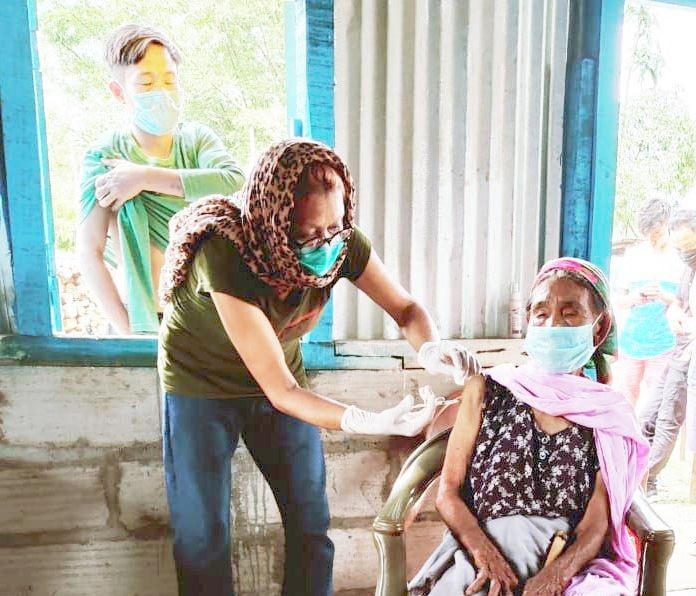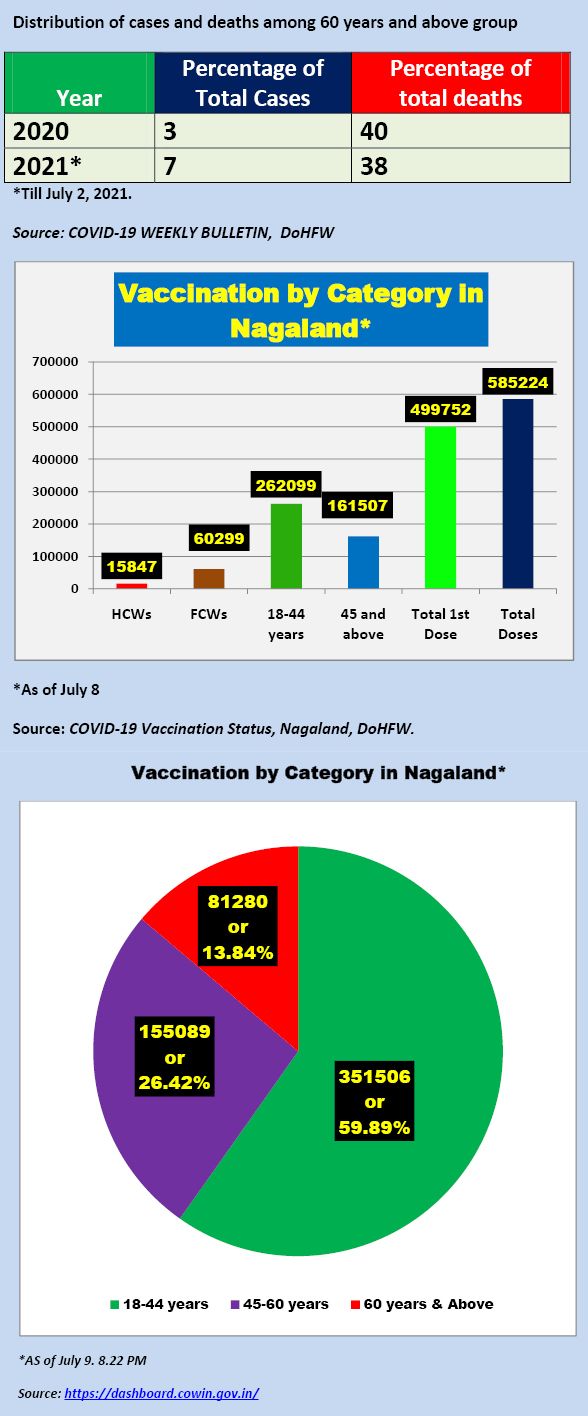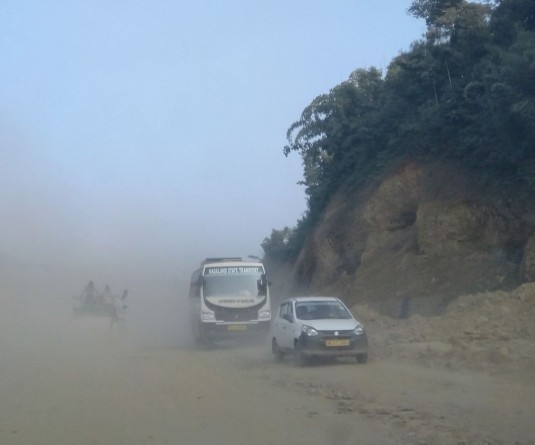An 87-year old woman of Sumi Settsü Village, Akuluto block receiving her first dose of COVID-19 vaccination on June 12. (Photo Courtesy: IEC Bureau, CMO Office Zunheboto)

Moa Jamir
Dimapur | July 9
As of July 8, Nagaland has administrated 4,99,752 eligible beneficiaries with the first dose and 85,472 with second dose of COVID-19 vaccines for a combined total of 5,85,224.
As per the Department of Health and Family Welfare (DoHFW), an estimated total of 13,54,722 beneficiaries are eligible for the vaccination in the 18 years and above category in the State.
Accordingly, while the combined total represented 43.19% of the targeted population, as it included those receiving both first and second dose, a clear picture on magnitude of vaccination can ascertained by looking at the first dose data.
As of July 8, a total of 4,99,752 beneficiaries had received their first dose representing 36.88% of the eligible population, informed the daily status update by the DoHFW.
The number of beneficiaries receiving both doses or ‘full vaccination,’ however, were 85,472 or just 6.3% of the targeted population, giving a snapshot of the uphill challenge that lies ahead for the State’s policymakers in ensuring the ‘safest way’ out of the COVID-19 pandemic in Nagaland.

According to an official source, the expected immunity of population for the virus to spread transmission is around 65-70%. This is subject to “immune escape by variants of concern” - mutation or discovery of new variants, which may be more resistant to existing vaccines.
However, the overall target is 90% coverage of eligible beneficiaries with at least the first dose. This is an ‘immediate need’ opined a health official, while admitting that it is still a long way to go.
The official’s predicament is understandable given the fact that as of June 8, it was 36.88% of the targeted population or indicating just around half of the percentage of ‘expected immunity of population’ (65-70%) and a long way off from the targeted 90%.
Low number among ‘key population’
No doubt, the overall pace of vaccination has gained momentum with the opening from May 17 this year. For instance, till May 14, the total doses in nearly four months was 2, 39,564. In just one month and 23 days, the number more than doubled to 5,85,224 till July 8.
However, the number for two ‘key populations’ still remained stagnant and may have implications for the future – vaccination among healthcare workers (HCWs) and those above 60 years and above.
According to the DoHFW’s data, out of 25,339 estimated HCWs, only 15,847 or 62.5% have received their first dose.
This is concerning for two reasons – the HCWs were the first category of beneficiaries when the COVID-19 vaccination drive kicked off nationwide on January 16.
Most importantly, among others, the HCWs are key to successful implementation of any immunisation drive in terms of service delivery and instilling vaccine confidence and crucial in the fight against the COVID-19.
The vaccinations among HCWs are low due to ASHAs (Accredited Social Health Activist), AWWs (Anganwadi Workers) and fourth grade staff, a health official at the forefront of the vaccination process bluntly stated, when queried on the issue.
Many just registered without thinking it over and a number of AWWs have also been vaccinated in the general population too, the official elaborated.
All others doctors, nurses and those in frontline, however, are ‘well-vaccinated’, he underscored.
Another departmental source also informed that the practice of keeping ‘proxies’ and ‘substitutes’ are also adding new dimensions to the process.
Low cases, high fatality
Meanwhile, the DoHFW’s status report has clubbed doses among 45-59 years and 60+ age groups together. However, vaccination among the latter, another key population, is also very low.
To assess the magnitude, one needs look at the CoWIN Dashboard, where further categorisation is given.
According to the CoWIN Dashboard, out of 5, 86,492 doses administrated in Nagaland, only 81,238 or 13.85 % were in the 60 and above category as of July 9, while a total of 3, 51,227 (59.88%) were in 18-44 category and 1,53,997 (26.25%) were in 45-60 category.
The number on CoWIN Dashboard tends to be lower than the State’s figure as there is certain time-lag in reconciling offline sessions on the portal.
At the time of filing of this report, the State’s figure for July 9 was yet to be issued.
The low percentage of 13.85 % among the 60 years and above category is also concerning if one analyses the percentage of positive cases and fatalities.
As per the COVID-19 Weekly Bulletin issued by the DoHFW on July 3, cases among 61-99 years age group was just 3% and 7% of the total cases in 2020 and 2021 respectively.
However, the vulnerability of the cohort can be ascertained by the ‘distribution of deaths by age group’ data given in the same bulletin.
In 2020, 40% of the deaths in the State occurred in the 60 and above category while so far in 2021, the percentage is 38%.
In other words, with just 3% of the total cases, the 60 years and above category accounted for 40% of total deaths in 2020 and so far in 2021, 38% of deaths were from the cohort with just 7% of the cases.
When queried on the issue and remedial steps being undertaken by the concerned authority, the health official said that the department is now reaching to all villages and doing near-to-home vaccinations for old people too.
“Vaccination has picked up in the last three weeks,” he added. Redoubling of vaccination efforts is crucial in curtailing the vulnerability of the 60+ category.






